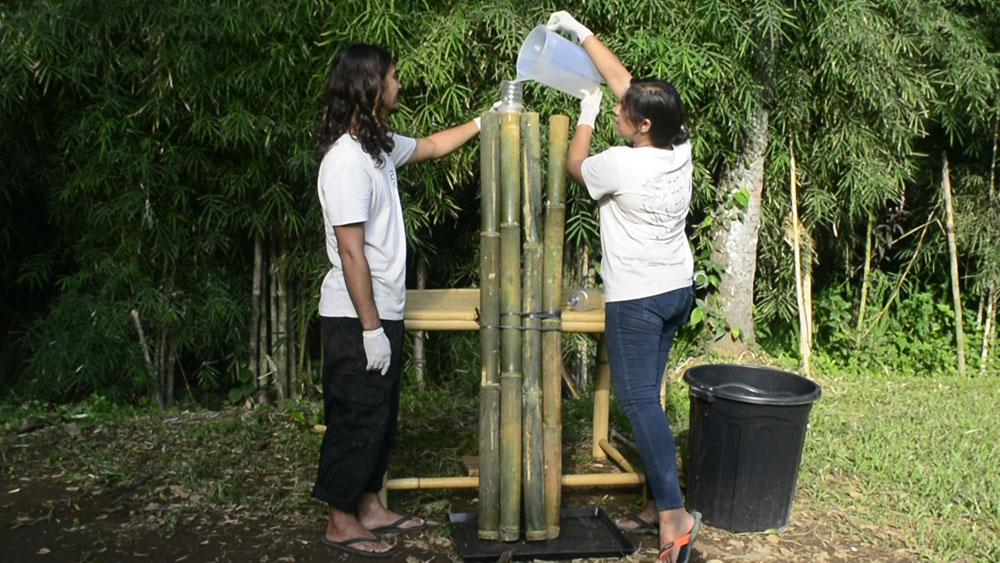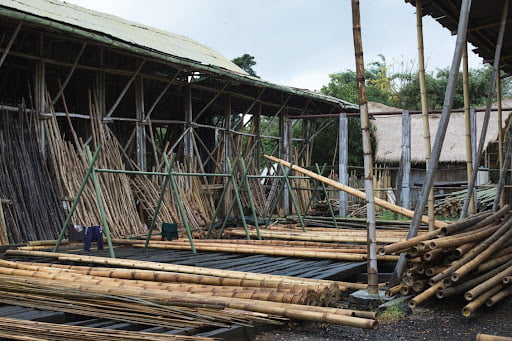The Ultimate Step-by-Step Guide To Treating Bamboo
By Rodrigo Istchuk | July 11, 2023 | Treatment -

Learn the simple, budget-friendly Vertical Soak Diffusion method for durable, long-lasting bamboo treatment.
Bamboo, a strong and sustainable material, is often under threat from insects like termites, beetles, and fungi. But don't let these pesky pests discourage you from using bamboo in your project. With a bit of know-how, you can prepare and treat bamboo to ensure its longevity and strength. This article will dive deep into a simple, budget-friendly bamboo treatment method called Vertical Soak Diffusion (VSD).
VSD is ideal for small or large projects alike, particularly if your budget is tight. Its beauty lies in its simplicity and effectiveness, requiring minimum equipment and investment. In this process, all the bamboo pole nodes, except for the last one, are punctured using a long, spear-headed iron rod. Then, the poles are positioned vertically and filled with a preservative solution. Visualize it as filling a lengthy bamboo cup with a lifesaving brew.
In this article, we share:
- The materials you need to treat your bamboo using this treatment method
- The steps to take to treat your bamboo
Materials You Need To Treat Bamboo Using The VSD Treatment Method
- Measuring tape
- Weight scale
- Borax - 0.9 kg or 900 grams
- Boric acid - 0.6 kg or 600 grams
- Protective gear (gloves, rubber boots, and eye protection)
- Warm water - 13.5 liters
- Containers, jugs, and a bamboo stick for mixing the solution
- Iron rod with a spearhead for puncturing the bamboo
- Funnel for pouring the solution
- End caps to cover the bamboo poles
- A basin, tub, or tank to place the bamboo and retrieve the solution after treatment
- Red Textile dye as an indicator of absorption (optional)
Step-By-Step Guide On Treating Your Bamboo
Step 1: Preparing the Bamboo
Before we start the process of treating bamboo, it's crucial to properly prepare the bamboo poles for treatment. Here's a detailed guide on how to go about it.
To ensure a successful treatment, it's crucial to select mature bamboo poles that are between 3 to 5 years old, depending on the species. As they age, the bamboo poles harden and become impermeable to the borax-boric acid solution. On the other hand, harvesting young bamboo is not recommended as it's not strong enough for construction.
Inspect the bamboo poles for any cracks and choose only those that are free of cracks or insect damage for treatment. It is best to wash the harvested bamboo poles to eliminate any mold or dust. Ideally, bamboo poles should be treated shortly after they are harvested. However, a short period of stand-curing, or resting the bamboo poles on a stand, can be beneficial as it encourages the natural drying process and aids in reducing the starch content in the bamboo.
 Tie the bamboo poles to a stand or table. Using an iron rod, puncture the bamboo nodes or diaphragms, with the exception of the last one. It's essential not to puncture the last node – a mark on the iron rod can help you remember where to stop. After the nodes are punctured, position the bamboo poles vertically and secure them in place.
Tie the bamboo poles to a stand or table. Using an iron rod, puncture the bamboo nodes or diaphragms, with the exception of the last one. It's essential not to puncture the last node – a mark on the iron rod can help you remember where to stop. After the nodes are punctured, position the bamboo poles vertically and secure them in place.

If you're dealing with longer poles, a scaffold—a temporary structure typically used in construction to support workers—can assist you in reaching the top of the bamboo. Alternatively, you can also place the bamboo poles on a steep hill, securing the bases against potential sliding and filling them from the top with the solution. The image below illustrates the use of scaffolding for handling taller bamboo poles.

By following these initial steps, you're ensuring your bamboo treatment process gets off to a good start. They are now ready to be treated with the borax-boric acid solution.
Step 2: Preparing the Solution
Two ingredients, borax and boric acid, form the heart of this treatment. Commonly found in crop fertilizers, household cleaning products and cosmetics, these substances are low in toxicity and more environmentally friendly compared to other common bamboo preservatives. Moreover, they don't pose a threat to groundwater when disposed of correctly.

Understanding how much preservative solution you need for your bamboo treatment can seem tricky, but it's as simple as calculating the volume of a cylinder - a process you may remember from your school math classes. Let's break it down:
First, measure the length and internal diameter of your bamboo poles. If there's some variation in the dimensions, select a pole of average size for your calculations. Here's a practical example:
Suppose you have four bamboo poles, each with a length of 1500mm (1.5m or 4.9ft) and an average internal diameter of 50mm. This makes the radius 25mm.
The volume of a cylinder is calculated using the following formula:
V = π x r x r x h
Where:
V = volume of the cylinder, in milliliters (cm³);
π = a constant value of approximately 3.14;
r = the radius of the bamboo pole, in cm;
h = the height or length of the bamboo pole, in cm.
Applying these numbers to our formula, we get:
V = 3.14 x (2.5)2 x 150
= 3.14 x 6.25 x 150
= 2943.75 cm3
Given you have four bamboo poles, multiply the volume by four:
= 2943.75 x 4 = 11,775 cm3
Next, convert from cubic millimeters to liters (1 liter = 1,000,000 mm3):
V = 11,775 / 1000 = 11.775 liters
To ensure you have enough solution, prepare about 15 liters, accounting for potential spillage and the fact that the poles will absorb the solution gradually.
Now, let's break down the composition of the 15 liters solution. The solution is 90% water, and the remaining 10% is a mix of borax and boric acid at a ratio of 6:4.
Therefore, you need:
90% Water = 13.5 liters
6% Borax = 0.9 liters/kg
4% Boric Acid = 0.6 liters/kg
100% Solution = 15 liters
Safety is paramount. Always wear protective gear such as gloves and goggles when handling borates, as they can cause skin and eye irritation. Keep the solution out of reach of children.
Warm the water to help dissolve the borax and boric acid more quickly. Mix everything until the borax-boric crystals are completely dissolved. If you wish to ensure complete penetration of the solution into the bamboo, you can add a red textile dye as an indicator of absorption.
Step 3: Treating your Bamboo
Let's delve into the final steps for bamboo treatment, which include applying the solution and drying the bamboo poles:
Begin by pouring the solution into the bamboo poles. You can do this using a simple funnel and jug, but for larger-scale operations, pumps and hoses may be more efficient. If any leaks are present in the bamboo pole due to holes, these can be repaired using bamboo or wooden pegs.

The borax and boric acid solution is gradually absorbed by the bamboo, removing starch and killing any insects within the poles. This absorption process typically takes between 14 days, depending on the bamboo species. The solution needs to be refilled daily until the indicator dye, if used, permeates the entire wall thickness of the bamboo. If you prefer not to use an indicator dye, testing for borax content may be necessary.
To prevent evaporation, cover the poles with caps or any effective sealing material. Ideally, this entire process should be carried out in a shaded area to minimize the impact of the sun on the bamboo poles and limit solution evaporation.
After about 14 days, puncture the final node using a small punching rod. The leftover solution can then be used to treat many other poles! Subsequently, dry the bamboo under shade to prevent uneven discoloration and cracking. Once fully dried, the bamboo is ready for use in construction.
With these steps completed, your bamboo poles are now ready for use in your creative endeavors! If you’d like to know more about bamboo treatment, propagation, design, and construction, we highly encourage you to join and immerse yourself in one of our online or in-person programs. Learn more here: www.bamboou.com/courses.

Rodrigo is a structural engineer from Brazil, specializing in bamboo structures and bio architecture. With a multidisciplinary approach, Rodrigo has been teaching, designing, and collaborating with various bamboo players around the world. For Rodrigo, bamboo is a tool to create meaningful change in people and the environment.
OCTOBER 10-21, 2025
The 11 Day Bamboo Build & Design Course in Bali
In 11 days, we'll show you how to build bamboo structures we’ll share all that it takes to build with nature.
Start Anytime
The Bamboo Harvesting Course
The Bamboo Harvesting Course is an online step-by-step training to harvest and care for your bamboo clumps to ensure their longevity and productivity. This maximizes the potential of this beautiful grass as a rapidly renewable resource.Whether you are an architect, builder, or sustainability enthusiast, this mini course will enable you to utilize this rapidly regenerative resource as a durable construction material.It will help remove any fear or doubt about the durability of bamboo and help you build reputable bamboo structures that stand the test of time!













